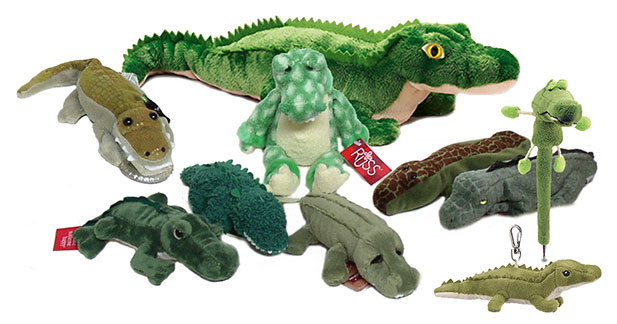

Alligator Plush Toys
Alligator stuffed animals and plush toys are at the Zoo at Animals N More.
Now that you have found yourself at the Zoo, check out these amazing plush toy Alligators and Crocodiles. They are cuddly and realistic, all at the same time.
You can buy these cute alligator and crocodile stuffed animals at our sponsor's website: Jeannie's Cottage LLC. The image above shows some of our alligator stuffed animals, a Russ Berrie Alligator Luv Pet, Wild Republic Snuggle Buddy Swampy Alligator, Swampy Alligator from Russ Berrie, Lou Rankin Everglade the Alligator stuffed animal, Ally the Ty Beanie Baby Alligator, Swampy the Ty Beanie Baby Alligator, a Crocodile Stuffed Animal from Wild Republic and a Wildlife Artists Alligator in back. There is also an alligator plush pen.
Alligators, crocodiles, gavials and caymans are all crocodilians,
which live in and along swamps, rivers and lakes of the tropics and subtropics. There are two species of alligator still living: the Alligator mississipiensis of the southeastern United States (10 feet long) and the Chinese A. sinensis, found in China. (5 feet long).
The existing crocodilians are divided into three families, Gavialidae, Crocodilidae, and Alligatoridae. The gavials are sparsely distributed in India, the Malay Peninsula and the East Indies. Crocodiles are found in suitably moist regions throughout the tropics. The alligators, which together with the caimans of Latin America, make up the family Alligatoridae, are largely restricted to the New World.
All of these reptiles dwell in water, where they prey on a wide variety of other animals. Crocodiles have a few teeth in the lower jaw that are larger than the others and that fit into notches on each side of the upper jaw. This gives them the grinning appearance that distinguishes them from the alligators, whose enlarged teeth fit into pits in the upper jaw.
These reptiles swim by means of sinuous movements of their muscular tail, in somewhat the same general way that a mackerel does, with their feet playing no important part of the propulsion. On land they are rather clumsy, slow and deliberate in locomotion, although they carry their body high off the ground with just the tip end of the tail dragging. When provoked, however, they lunge forward with great rapidity, or wield their tail as a powerful defense weapon.
Crocodilians prey on a variety of animals including crayfish, shrimp, snakes, turtles, birds, fish, frogs, muskrats, raccoons and sometimes other larger animals. They have been known to attack humans.
Alligators make burrows in the banks of rivers. These they retreat into during the summer. They cannot tolerate high temperatures. They appear to prefer temperatures between 75 and 85 degrees Fahrenheit.
Crocodilians lay eggs. The female deposits her eggs in a nest that she makes by gathering vegetable trash and mud. Sometimes the nest may be over a yard high, and more than six feet across. After laying the eggs she covers them with the same sort of nest material. She leaves a small opening to allow the young to escape when they hatch about eight weeks later.
The young grow rapidly. Being about 8 inches long at birth, they will double their size in one year. It then grows about a foot each year until it reaches 10 feet. The growth rate slows after that. Alligators have been known to reach lengths of 14.5 feet. Crocodiles beat that by reaching lengths of 20 feet.
The lifespan of these reptiles is about 50 years on average. Some records indicate they could go as high as 100 years, but that would be very rare.



